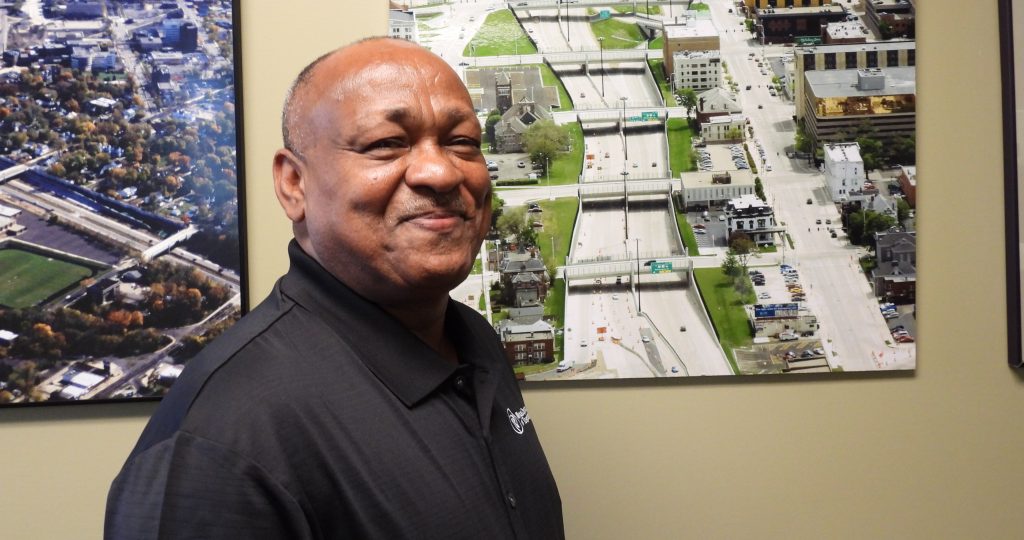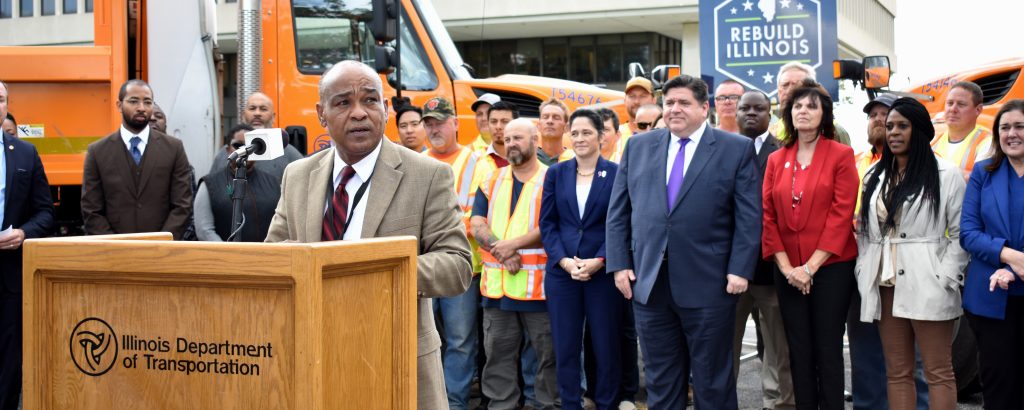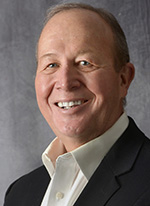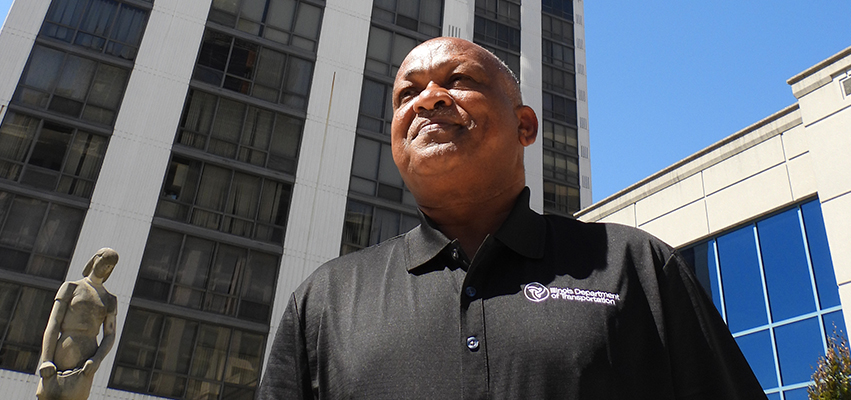So what do you get when you cross Sudanese pride with a Midwestern humility and work ethic?
Why, you get Illinois’ 13th transportation secretary, that’s what, as well as the first Peorian to occupy that position, the first person of color, and just the third IDOT lifer to rise to the top.
In short, you get Omer Osman, 58, who should be a familiar name in central Illinois, as an engineer who spent most of his career working out of the Peoria office of the Illinois Department of Transportation (IDOT), with his fingerprints on many of the most significant projects hereabouts since the 1990s.
Today, he’s the top transportation official in a state with one of the largest, most diverse, most complex infrastructure networks in America, overseeing an annual operating budget of some $3.8 billion, a capital budget topping $27 billion, and the work of some 5,000 employees.
The ascendance has been impressive and the journey long for Osman – almost 6,800 miles, in fact.
Where it all started
Omer Osman was the fourth of 11 children born to Zumrawi and Fatima Osman in Kerma, Sudan, the area that gave rise to the Nubian Empire and the “Black Pharaohs” whose 25th dynasty ruled Egypt for nearly a century.
He is a proud descendant of that history and tradition, though his own origins were humble enough.
His father, Zumrawi, attended school through fourth grade, when he quit to help Osman’s grandfather start a grocery in northern Sudan, much needed by their village. His mother, Fatima, “didn’t know how to read or write” but was smart and selfless and “dedicated her life to raising 11 kids.”
His father, the self-made businessman with a calculator in his head, did well financially by local standards but recognized that the most important gift he could leave his children was an education. Today, all 11 children – Osman has eight brothers and two sisters, split between America and overseas – brag a college diploma in architecture, engineering, medicine or business, despite growing up in a Third World country where books could be hard to come by.
“Without him pushing us, we wouldn’t be where we are as a family,” said Osman, who mastered English by watching American soap operas and westerns. “It was all about ‘The Good, the Bad and the Ugly,’ Clint Eastwood and all that. I was fascinated with it.”
Osman grew up in the countryside until age 14, at which point the family moved to Khartoum, Sudan’s capital city, in a metro area of 6 million people. “For me, it was a culture shock,” but it’s where he would graduate from high school, entertain thoughts of medical school, and prepare to further his studies in Bulgaria. Until his father intervened, that is.
He “talked me into going to the U.S.A.,” and soon Osman was on a TWA jet to New York, then New Orleans, then Baton Rouge. He’d take classes to refine his language skills at Louisiana State University, mentored by professors who took a special interest in this “shy guy,” then enroll at Southern University, a historically black college with a fine engineering program. For this self-proclaimed student of history, the rest is exactly that.
Peoria bound
Upon graduation, Osman thought he might be headed back to Sudan. Then a fellow student who’d graduated the year before and gone to work at IDOT returned to Louisiana on a recruiting trip. She put a map of Illinois before him, pointed to the Chicago area, then to Peoria.
“That’s a funny name. Where’s Peoria?” Osman asked. “She said, ‘Caterpillar.’ … I said, ‘I want to go to Peoria because of Caterpillar.”
The next thing Osman knew, he was interviewing in District 4 Engineer Dale Risinger’s office in Peoria, decked out in his Sunday best – suit, shirt, tie, shoes, $100, all in – when Risinger, who would later be elected a state senator from Peoria, asked the candidates where they saw themselves in five years.
“Mr. Risinger, five years from now, if I’m not sitting on that chair of yours, I’ll be somewhere around it,” a nervous Osman somehow found the courage and boldness to blurt out. “Dale started laughing, I started laughing with him,” and they remain friends to this day.

Risinger confirms Osman’s recollection. “He was bright and he had initiative,” and he has earned everything that has come his way, said Risinger, noting the exceptional work he did on the I-74/Murray Baker Bridge reconstruction, one of the most challenging and expensive projects in downstate history.
“He is obviously a good guy … and he does a great job,” said Risinger. Not only is the work demanding from a technical perspective, but “it’s a tough job because there’s a lot of politics involved in it, as you might imagine.”
Rising through the ranks
That interview was 34 years ago. Before long, Osman was moving up the ranks from planning to design to on-site construction, working on major road and bridge projects such as the expansion of Route 29 north of Chillicothe, all while somehow finding time to get his master’s degree at Bradley University, in 1995.
He was involved in the conversations around the completion of the ring road when that was the central Illinois project of the moment, and worked on improvements of the Shade-Lohmann Bridge over I-474, the McClugage Bridge, and then the granddaddy of them all, the half-billion-dollar Upgrade 74 project that from 2002 to 2006 saw the wholesale reinvention of the interstate and Murray Baker Bridge through Peoria and East Peoria.
“That was as complicated a design as I have ever seen,” said Osman, who laughs now about standing beneath the bridge with another colleague when 180 feet of it was effectively being sawed off “because if that bridge failed, we wanted to die.” He credits Ray LaHood – Peoria’s congressman at the time and later U.S. transportation secretary under President Barack Obama – for making the project happen. Years later, that stretch of road became Ray LaHood Highway, though Osman jokes – as he often does — about telling LaHood, “If you get us $500 million, I’ll get you a $200 sign.”
“The truth is, that’s one of the safest interstates in the country, and it wasn’t before,” said LaHood. “He (Osman) knew what it takes to get things done.
“The interesting thing about Omar, he’s kind of the epitome of the American dream,” said LaHood, who remembers Osman coming to his congressional office to inquire about becoming a U.S. citizen. “He worked his way up … Obviously, Gov. Pritzker saw some real talent in this guy.”
On June 1, 2021, Osman was confirmed as transportation secretary by the Illinois Senate after serving as acting IDOT director since 2019, assuming responsibility for one of the largest transportation networks in America — 300,000 lane miles of roads and bridges, some 80 airports including one of the world’s busiest at Chicago O’Hare, bustling urban mass transit systems, a rail system contributing to 25 percent of the nation’s freight coming through Illinois, and waterway infrastructure.
Priorities
It’s not easy managing the demands of a large and diverse state – five IDOT regions incorporating nine districts — where virtually every community has a pet project and a strong desire to get help paying for it.
How does Osman balance all that?
It starts with recognizing that “what works in Chicago does not work in Carbondale,” he said. As a guiding principle, “department wise, our number one mission is preserving the infrastructure that we have today,” said Osman, adding that data – “specific input safety-wise, traffic-wise, investment-wise” — drives the department’s decision-making like never before. While there are regional considerations, “at the end of the day … what’s in the best interests of the entire state of Illinois?”

Meanwhile, IDOT is whittling down the state’s backlog of projects, some of which have been waiting on funding for decades. There also is a new emphasis on multi-modal transportation that allows access to hikers and bikers, such as the protected path that will accompany Peoria’s eastbound McClugage Bridge span.
That’s not to say Osman isn’t partial to some projects. In the Peoria area specifically, community leaders are pushing for passenger rail. That has a formidable price tag, into the billions, which Osman defends as an investment of statewide impact that benefits not just Peoria but many communities between here and Chicago, with improvement/replacement of 700 to 800 miles of track that will aid not just passenger but freight rail for decades to come, “kind of like redoing 55 from Bloomington all the way to Chicago.”
Meanwhile, “Route 29 was my baby. I want Route 29 to be fixed through Peoria Heights/Peoria”, he said, with U.S. 24 due for a long-awaited widening to four lanes.
Unexpected challenges
“When I took over, the number one priority was coming up with an infrastructure bill,” said Osman, who helped Gov. Pritzker provide accurate information to lawmakers and communicate priorities.
Then came COVID, and negotiating with the unprecedented nature of all that. “I’ll never forget March 17 (2020),” he said. “I had to send everybody home.” Work on some projects came to a halt, deadlines were missed, but it was critical that commerce continue, ensuring that the goods that make society function could be safely and efficiently delivered – to hospitals, to grocery stores, etc. – with IDOT wholly committed to making that happen, in part by keeping the state’s 42 rest areas open 24-7 for tired truckers.
Keeping up with technology and innovation, recruiting top talent, and diversifying the staff at IDOT remain top-of-the-list missions, said Osman.
Illinoisans see the final product. What the public doesn’t see is the core planning, design and problem-solving that go on behind the scenes to bring everything together. “Not being cheesy, the absolute dedication of department employees is top-notch,” he said.
The ultimate goal?
“I want the state to still be identified as the true transportation hub of the nation, and we are,” he said.
Personal/Professional

Magda is Osman’s wife of 24 years, a medical doctor and mom to the couple’s three children ages 15 to 20 — sons Khalid and Waleed and daughter Nadeen. “My backbone … is my wife, no question,” he said.
Osman counts as professional mentors Risinger and former IDOT bosses and colleagues Joe Crowe, Annette Mills and Jim Easterly.
He has big, nice offices in Springfield and Chicago but continues to sleep at home in Peoria, much of the time.
“I’m going to do this as long as the governor wants me,” Osman said. “This governor has been an infrastructure governor … He literally gave me billions of dollars to play with … This is fun.”
What would Osman’s young Sudanese self think of his accomplishments today?
“Where I grew up … we are an extremely proud people, culturally. We believe in self-reliance. We believe in pushing the limits,” he said. Whatever recognition he gets back in his homeland reflects well on “your family … your region … your values.
“To see a smile on one of my countrymen that I made it to the top – ‘This is Omer, the son of so and so’ – that my dad did a good job raising me … That means the world to me.”





